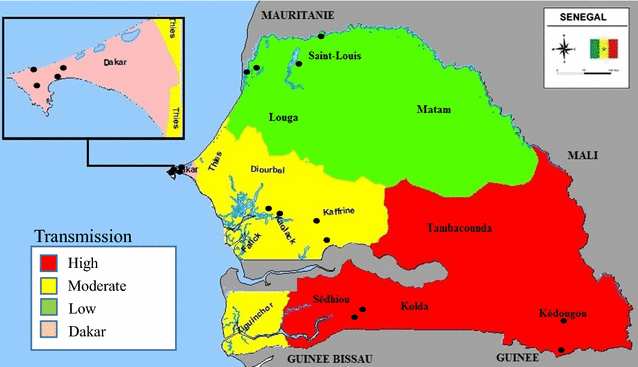Assessment of the utility of a symptom-based algorithm for identifying febrile patients for malaria diagnostic testing in Senegal
- PMID: 28249580
- PMCID: PMC5333468
- DOI: 10.1186/s12936-017-1750-y
Assessment of the utility of a symptom-based algorithm for identifying febrile patients for malaria diagnostic testing in Senegal
Abstract
Background: Malaria rapid diagnostic tests (RDTs) enable point-of-care testing to be nearly as sensitive and specific as reference microscopy. The Senegal National Malaria Control Programme introduced RDTs in 2007, along with a case management algorithm for uncomplicated febrile illness, in which the first step stipulates that if a febrile patient of any age has symptoms indicative of febrile illness other than malaria (e.g., cough or rash), they would not be tested for malaria, but treated for the apparent illness and receive an RDT for malaria only if they returned in 48 h without improvement.
Methods: A year-long study in 16 health posts was conducted to determine the algorithm's capacity to identify patients with Plasmodium falciparum infection identifiable by RDT. Health post personnel enrolled patients of all ages with fever (≥37.5 °C) or history of fever in the previous 2 days. After clinical assessment, a nurse staffing the health post determined whether a patient should receive an RDT according to the diagnostic algorithm, but performed an RDT for all enrolled patients.
Results: Over 1 year, 6039 patients were enrolled and 58% (3483) were determined to require an RDT according to the algorithm. Overall, 23% (1373/6039) had a positive RDT, 34% (1130/3376) during rainy season and 9% (243/2661) during dry season. The first step of the algorithm identified only 78% of patients with a positive RDT, varying by transmission season (rainy 80%, dry 70%), malaria transmission zone (high 75%, low 95%), and age group (under 5 years 68%, 5 years and older 84%).
Conclusions: In all but the lowest malaria transmission zone, use of the algorithm excludes an unacceptably large proportion of patients with malaria from receiving an RDT at their first visit, denying them timely diagnosis and treatment. While the algorithm was adopted within a context of malaria control and scarce resources, with the goal of treating patients with symptomatic malaria, Senegal has now adopted a policy of universal diagnosis of patients with fever or history of fever. In addition, in the current context of malaria elimination, the paradigm of case management needs to shift towards the identification and treatment of all patients with malaria infection.
Keywords: Algorithm; Case management; Diagnosis; Fever; Malaria; Rapid diagnostic test; Treatment.
Figures
References
-
- Ministère de la Santé, de la Prévention et de l’Hygiène Publique/PNLP. Capitalisation de l’introduction des ACT au Sénégal. Rapport Etude IPDSR/UCAD. 2009.
-
- Ministère de la Santé et de la Prévention Médicale/PNLP. Etude de la faisabilité des TDR au Sénégal. Rapport Etude du Laboratoire de Parasitologie de l’UCAD. 2007.
-
- Ministère de la Santé, de la Prévention et de l’Hygiène Publique/PNLP. Capitalisation de l’introduction des TDR au Sénégal. Rapport Etude IPDSR/UCAD. 2009.
Publication types
MeSH terms
LinkOut - more resources
Full Text Sources
Other Literature Sources
Medical



